
AAST Energy Research Unit and Energy Management Committee focus on divesting from carbon intensive industries by directing investments and research towards green clean energy and carbon emissions reduction, as well as expansion in renewable energy employment. This is demonstrated in Green Energy and Energy Management Policy which includes within its context AASTMT commitment to conduct Investments and Research towards low-carbon renewable energy sources as well as energy efficiency and decarbonization aspects.
Check on the AASTMT news page
The Investments and Research aspects in this policy include the following;
Investments
Research
Moreover, there is the Sustainable Investment Policy-statement which focuses on investments in Renewable Energy initiatives, including but not limited to wind, solar, hydro, and bioenergy projects.
Check Sustainable Investment Policy on the AASTMT news page
Towards Green Renewable Energy Expansion, AASTMT takes consistent measures that are continuously carried out, besides yearly updated ones. This is reflected in the increase of low-carbon sources’ share in AASTMT total energy supply, as well as in the implemented innovations and prototypes of related projects and investment. These measures are detailed in AASTMT 2024 plan towards Green Sustainable Energy and their effectiveness are validated in 2024 Energy Progress Report, as summarized below.
AASTMT 2024 Plan towards Clean Sustainable Energy
AASTMT 2023/2024 Energy Progress Report
Starting from 2022 along to 2024, AASTMT took consistent steps towards renewable energy (RE) sources employment, with a particular focus on solar power, by installing and functioning about 230 kW solar of photovoltaic (PV) side and mounted stations as well as solar heaters as follows,
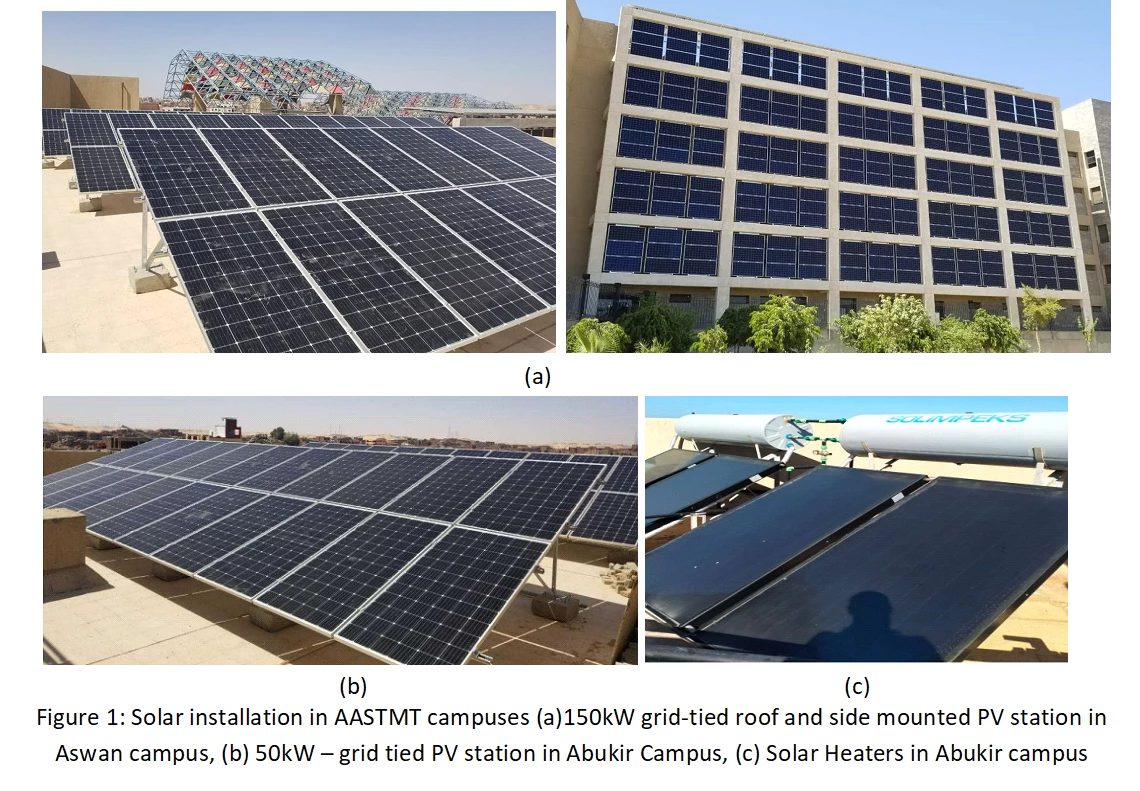
However, to sustain and expand AASTMT efforts towards renewable energy solutions, regular measures are taken into account, besides initiatives and projects initiated annually to serve this goal.
1. Regular Measures
These Labs include;
# Energy Research Unit LAB in 7th Engineerring Building - Alexandria Headquarter
# Energy LAB in Eletrical Energy Engineering Department - Smart Village Campus
Eletrical Energy Engineering LAB
# Environmental Monitoring and Climate Change Laboratory - Scientific Research & Innovation Centre
Environmental Monitoring and Climate Change Laboratory
2. AASTMT 2024 Plan
Annually, AASTMT participates in renewable energy-related projects and improves the outcomes of already existing ones to serve the industry and community effectively and resourcefully. Besides, campaigns and technical talks are organized to increase the awareness about RE importance and technicality. Moreover, studies are conducted for renewables expansion in AASTMT infrastructure and facilities.
2024/2025 Study and Proposal for establishing PV station and EV charging units in Alamein Branch
It presents the essential need to prepare students with a comprehensive background in renewable energies via three experimental kits. These lab experiments help the students understand the main concepts regarding renewable energy, energy measurement and energy storage. The three main resources are Solar, Wind and Fuel Cell. The laboratory serves renewable energy courses and summer school camps.
Renewable Energy Lab in EE Dept-AAST Abukir
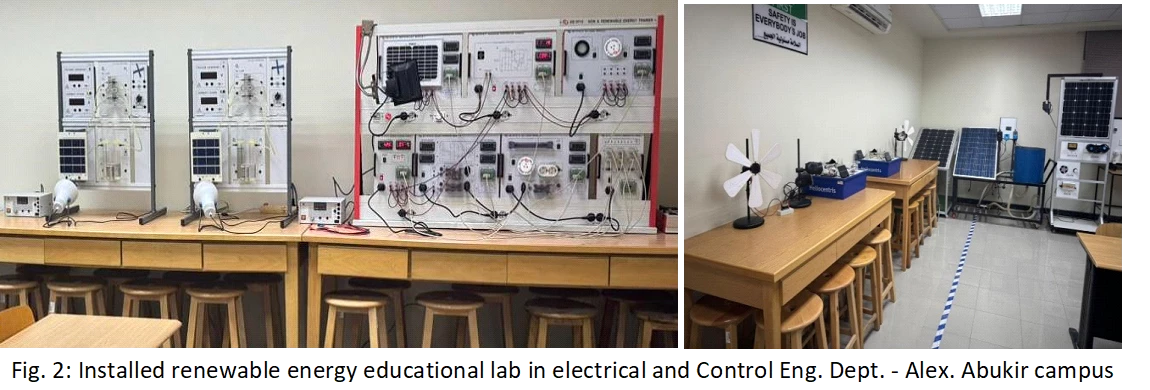
The Renewable, Innovative and Integrated Water Treatment Unit designed in 2023 in the TREATMENT Project was installed and put into action in 2024. This unit uses energy harnessed from 7kW photovoltaic system to be used to lift water from a well, and subsequently, the water is directed through the four-stage nano-filter, where it undergoes a rigorous purification process. The end result is clean, potable water or water suitable for irrigation and cultivation and almost 7kW PV system, serves as the sustainable energy source for the three-phase pump.
Water Treatment Unit Report-May2024
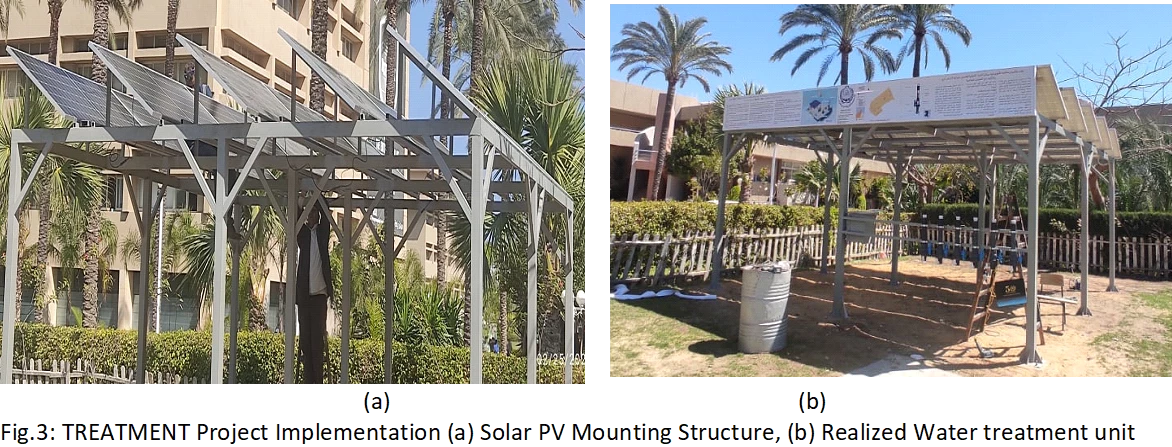
Renewable Energy-related Events
Renewable Energy-related Activities
Renewable Energy Research Projects
Renewable Energy Graduation Projects
Renewable Energy-related 2024/2025 Projects in AASTMT Industry Service Complex include,
# Smart Solar Waste Compactor
“Smart Solar Waste Compactor,” aims to develop an intelligent device for compacting plastic waste in various institutions such as schools, hospitals, and factories, relying primarily only on solar energy as its main power source. This project represents a practical solution that helps reduce plastic pollution, promotes the concept of a circular economy, and encourages institutions to sort their waste and gain financial returns from it.
# Solar Agricultural Robot
This is an integrated agricultural robot powered by solar energy and considered the second of its kind in the region. The robot was developed through joint funding from AASTMT and businessman Eng. Ahmed Abu Hashima in the project, named “LiDAR Navigation IoT Solar Agribot”. This project aims to support smart clean and sustainable farming and reduce reliance on manual labor, particularly in desert and muddy environments.
# Liquid Tree
An environmental photobioreactor, powered by solar energy, is implemented to purify the air and produce oxygen using marine algae. The project is a low-cost version of a model used in the UAE, which costs around $10,000, while the students managed to build the unit in Egypt for less than 15,000 EGP. The amount of oxygen produced by this system is equivalent to that of ten mature trees, making it suitable for use in parks, schools, and crowded urban areas.
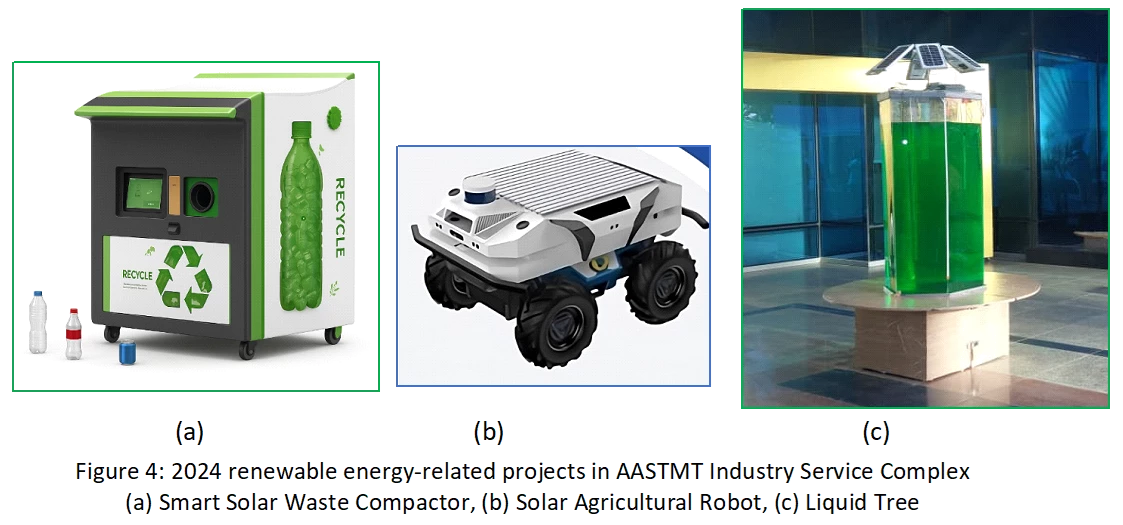
AAST commitment to divert to renewable clean energy is vivid in its investments and research in the field of low-carbon sustainable energy as discussed before. Moreover, for further validation, the share of low-carbon sources in AASTMT energy supply is discussed in 2024 AASTMT Energy and Carbon Insights Report and summarized below;
AASTMT 2024 Energy and Carbon Insights
AASTMT energy demand is supplied mainly from the Egyptian national grid in which the renewable energy (RE) share has increased from 6.3GW in 2022 to 6.7Gw in 2023 till reaching 8.6GW in 2024 as per NREA Report 2024, achieving an increase by almost 6.3% from 2022 to 2023 and by 28.4% from 2023 till 2024 as shown in Fig.5. Besides renewable energy contributed in AASTMT from national grid, there are almost 230 kW solar energy installations on AASTMT campuses buildings, with production reaching almost 75989 kWh in 2024. The latter shows an increase of almost 1.3% from the 75000 kWh solar installations in 2023 as shown in Fig. 5.
This reflects AASTMT efforts to divert to clean energy, energy efficiency, reduce emissions and sustain serving the Environment. Conclusively, AASTMT average renewable energy share in supplying its total energy demand (including RE share in national grid and its solar installations) reached above 25% in 2024 which is more than the 24% in 2023, reflecting AAST continuous efforts and investments to increase its RES installations, meeting its roadmap of achieving 25% RES share by 2025 and progressing towards it long-term goal of 40% RES share by 2040.
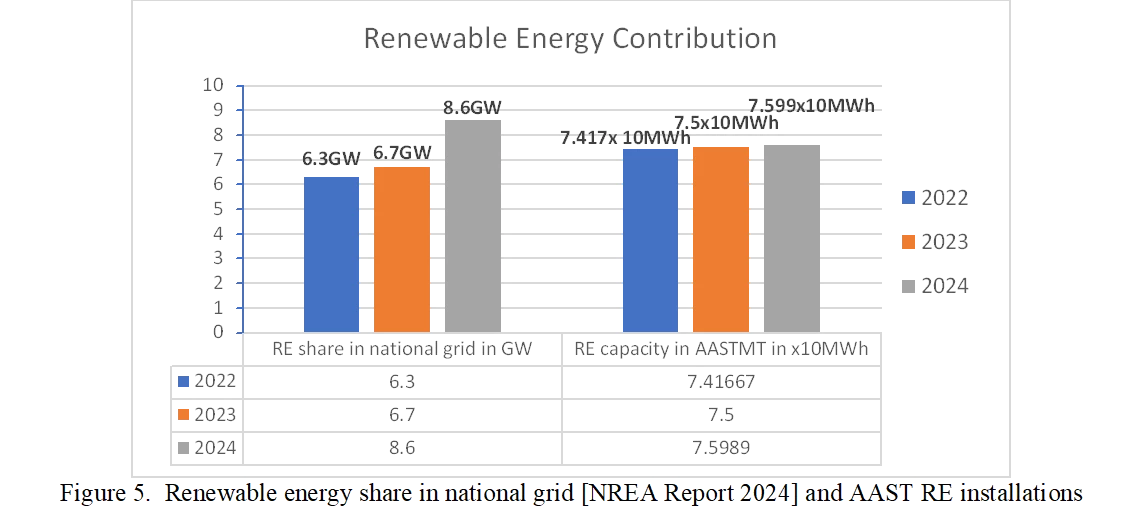
Table 1 shows the entire AAST energy density, including energy from national grid and from AASTMT total solar installations, in kWh/m2 and GJ/m2 in 2024 compared to that of 2023. The calculated energy density reached about 0.09363GJ/m2 in 2024 which is less than the 0.09785GJ/m2 in 2023 by almost 4.3%, mirroring AASTMT continuous efforts towards electrical energy conservation and energy efficiency improvement. Also, it is worth noting that AASTMT total energy consumption from low carbon sources (summing up RE sources share in national grid and solar installation in AAST), has reached 17494GJ in 2024 which is more than the 17271GJ in 2023 by almost 1.29%, reflecting AASST support to transition to clean energy.
Table 1. Energy Density in GJ/m2 for the entire AAST in 2024 compared to 2023
|
Year |
Total Floor Area (m2) |
Total energy (kWh) (from Grid + AAST solar infrastructure) |
Total energy (GJ) (from Grid + AASTMT solar infrastructure) |
Density (GJ/m2) |
Energy from low carbon sources (GJ) |
|
2023 |
735569.7 |
19,992,470 |
71972.892 |
0.09785 |
17271 |
|
2024 |
735569.7 |
19,131,865 |
68874.714 |
0.09363 |
17494 |
Over the course of 2022 and 2023, AASTMT made significant strides in transitioning to renewable energy sources, with a particular focus on solar power. The university expanded its solar infrastructure by operating 214 kW of photovoltaics and solar panels which contributed in increasing AAST renewable energy share supply to 24% of AASTMT total energy needs in 2023. This growth was made possible through further investments in renewable energy infrastructure as well as improvements in the maintenance and operation of existing solar installations. Moreover, in 2022/2023, AASTMT has significantly expanded its contributions to renewable energy and climate change through investments, research and projects as well as grants and innovations whose outcomes flourished within this period.
Related measures are detailed in AASTMT 2022/2023 Energy Progress Report and summarized below;
- Energy Research Unit LAB in Seventh Engineerring Building - Alexandria Headquarter
- Energy LAB in Eletrical Energy Engineering Department - Smart village campus
Eletrical Energy Engineering LAB
- Environmental Monitoring and Climate Change Laboratory - Scientific Research & Innovation Centre
Environmental Monitoring and Climate Change Laboratory
It is worth noting that a number of renewable energy- related projects, undertaken by AASTMT, have resulted in significant outcomes in 2022/2023. Some examples are listed below.
- MAIA-TAQA Project (2019-2023)
An important outcome of this project is “The Innovation One Stop Shop (IOSS)” in the Energy research Unit LAB installed and operated in 2022. The IOSS main purpose in AASTMT is to support startups and industry with business models, besides being used for training and consultancy purposes with components and facilities related to Renewable Energy.
- Smart Solar-Powered Public Parking System Project
This project was funded by Information Technology Industry Development Agency’s (ITIDA) and Information Technology Academia Collaboration (ITAC). This was followed by a related project, “Smart Integrated On-Board Battery Charger for Electric Vehicle Applications”. As an output of these projects, AASTMT Research and Development Center at Alamin campus designed and implemented two setups (PV-based Electric Vehicle Charger and Solar Power Smart Parking Meter) in AAST Abukir Campus in 2023 as a prototype for more duplicates.
Smart Charger for Electric Vehicle
- An Environmentally Friendly Electric Car Project
An electric car, that uses water and hydrogen, was invented by a student team from the Institute of Technical and Vocational Studies at AASTMT Industry Service Complex (ISC) in 2023.
- Monitoring, Assessment and Innovative Treatment Technology to Enhance Groundwater Quality for Irrigation Purposes toward Climate Change Adaptation (TREATMENT) Project
In 2022/2023, a Renewable, Innovative and Integrated Water Treatment Unit is designed to use energy harnessed from solar photovoltaic system to be used to lift water from a well, and subsequently, the water is directed through the four-stage nano-filter, where it undergoes a rigorous purification process. The end result is clean, potable water or water suitable for irrigation and cultivation and the PV system, serves as the sustainable energy source for the three-phase pump.
The AAST energy consumption is supplied mainly from the national grid in addition to solar energy in average 214 kW installed on AASTMT campuses buildings in 2022/2023.
Note that the national grid has 20% renewable energy according to National renewable energy Authority (NREA report 2022), as illustrated in Figure 6 (a) , and the national renewable energy share increased by almost 6% in 2023 as illustrated in Figure 6 (b). This contributed, besides the already installed 214 kW solar energy, to increase AASTMT average renewable energy share in supplying its total energy demand to around 24% in 2022/2023, as illustrated in AASTMT 2022/2023 Insights.
As shown in Table1, in 2022/2023, 270 GJ are supplied from renewable energy resources existing within AASTMT infrastructure which reflects AASTMT efforts to divert to clean energy, increase energy efficiency, reduce emissions and sustain serving the Environment. Moreover, Table 2 shows that 2022/2023 AASTMT total energy use from low-carbon renewable sources are 17271 GJ (270 GJ renewables installed in AASTMT and the rest from renewables’ share in national grid) representing almost 24% of AASTMT energy supply.
|
Table 2: Low-carbon Energy Use (2022/2023) |
|
|
Total energy used |
71972.892 GJ (71702.892 GJ from national grid + 270 GJ from renewables installed in AASTMT) |
|
Total energy used from low-carbon sources |
17271 GJ (270 GJ renewables installed in AASTMT and the rest from renewables’ share in national grid) |